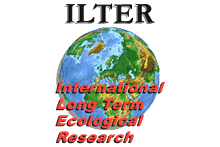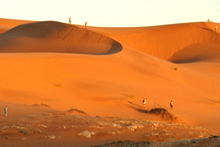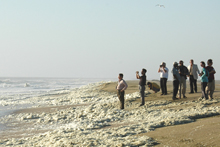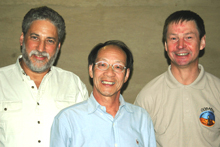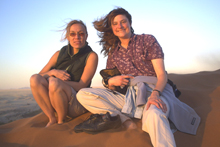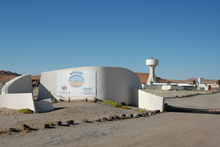ILTER CONFERENCE 2006: Monitoring our variable environments
From 13 to 19 August, 60 delegates from all corners of the world converged on the Namib Desert for the International Long-Term Ecological Research (ILTER) Conference 2006. The conference was hosted by the Gobabeb Training and Research Centre, which is located in Namibia's Namib-Naukluft Park, on the Kuiseb River, approximately 120 km from Walvis Bay.
|
The choice of venue was in keeping with the International Year of Deserts and Desertification, and its theme: Proud of our deserts while combating desertification.
ELTOSA Workshop and AGM
The first day, 13 August, was devoted to a full-day workshop and Annual General Meeting of the Environmental Long-Term Observatories of Southern Africa (ELTOSA). SAEON's Johan Pauw, representing South Africa, currently serves as ELTOSA Chairman for a term of two years.
|
The programme included the ELTOSA Chairman's annual report, as well as reports by representatives of the member countries: Namibia, Malawi, Mozambique, Botswana, Seychelles, South Africa, and North Africa. "As fundraising remains a problem for the network, several fundraising proposals were submitted over the past year but without major success," says Johan.
ELTOSA obtained support from the USLTER, National Research Foundation (NRF), University of Hamburg and the National Research Council of Malawi for its past two meetings that were organised by Chancellor College of Malawi and Gobabeb Research and Training Centre in Namibia. The SAEON National Office provided significant administrative support for these meetings.
The country reports can be summarised as follows:
Namibia, in particular the Gobabeb Training and Research Centre, is a positive and significant participant in ELTOSA and ILTER, and serves on several ILTER committees. Long-term reporting is progressing well in this country. The country also hosts and participates in the BIOTA South project, focusing on desert margin initiatives, biodiversity in the southern hemisphere, weather programmes, the coordination of observation sites, and grassroots level local monitoring.
Malawi, last year's host of the ELTOSA Workshop and AGM, has just been accepted as a fully-fledged member of ELTOSA, and this enthusiastic new entrant was warmly accepted into the ELTOSA fold.
Mozambique, which has been a member since 2003, is seen as an important player in ELTOSA, and has its own network of observatories in place.
Botswana is grappling with internal politics and progress has been slow. The key player at the moment is the Harry Oppenheimer Okavango Research Centre of the University of Botswana, which specialises in natural resource management research in the Okavango River Basin and Kalahari Desert Region. The research is undertaken by Centre staff in cooperation with visiting academics from associate institutions, and supported by graduate students from the University of Botswana. The aim of the Centre is to support the development of sustainable resource use by local communities in the whole river basin so as to promote its long-term conservation.
It was the Seychelles Islands' first exposure to ELTOSA, and their representative, Didier Dogley, has expressed interest in becoming a member. Read an interview with Didier Dogley.
The country reports session was followed by a general discussion on country networks, common issues and challenges. Delegates sought to identify areas of greatest common interest among the environmental issues facing their respective countries, first at a regional then at an international level. Potential candidates included the expected contemporary research 'hot-spots' of climate change, biodiversity, land degradation, and desertification.
"ELTOSA delegates were not hesitant in identifying water-related issues as an initial vehicle for collaborative research in the sub-region," says Johan. " Interest stemmed from a shared experience of ever-increasing demands on water and catchments that threatened livelihoods, and had potential downstream consequences for biodiversity and ecosystem functioning."
|
To end off the day's programme, there was a preliminary discussion on ILTER strategic and operational plans, and SAEON'S Avinash Chunthapursat gave delegates some information on the 2007 ELTOSA Workshop and AGM, which is to be hosted by South Africa.
ILTER Conference
The ELTOSA Workshop was followed by an ILTER Conference that consisted of full-day meetings held on three days by the ILTER Coordinating Committee, and a full-day science programme. The theme of the conference was On the Move: Monitoring our Variable Environments.
ILTER Chairman Hen-Biau King of Taiwan presided over the Conference. The high premium that the Namibian government places on the environment and environmental observation was demonstrated by the presence at the official opening ceremony of the Namibian Minister of the Environment, Mr Willem Konjore.
According to Johan, ILTER is undergoing a 10-year strategic planning process, and the plan was ratified at the meeting. In the past, ILTER used to be US dominated. One of the objectives of the new strategy is to broaden ILTER's international base and to attract international funding. A substantial European regional network already operates within ILTER, which is funded by the European Commission and the European Union. Two new members, Italy and Malawi, joined ILTER this year.
Three subcommittees function under the structure of the Coordinating Committee: a Science Committee, Information Management Committee and Fundraising Committee. SAEON's Avinash Chunthapursat was elected Vice-Chairman of the ILTER Information Management Committee. The committees are to convene in the near future to clarify work procedures and explore synergies for future cooperation.
The financial strategy and business plan of ILTER also came under scrutiny at the meeting, as well as criteria governing conduct of members.
|
"South Africa is a fully active member of ILTER, and is currently contributing financially to the management and implementation of the 'new' ILTER," says Johan. "In the year ahead at least two staff members will be employed on a full-time basis to roll out and implement the strategy, and it is envisaged that a full-time office will be established within a three-year period to manage ILTER affairs." Various management models for the function are currently being appraised, including that of the Global Biodiversity Information Facility (GBIF).
The quest to find a suitable ILTER host organisation among the member countries gave rise to a lengthy debate. "My guess is that it will be located somewhere in Europe," says Johan, "even if it's just for the sake of interconnectivity."
Field trips
A full day was set aside for field trips and site visits to the Kleinberg Observatories, BIOTA observatory near Gobabeb, other locations of interest in the central Namib, and Walvis Bay, Namibia's principal port. Delegates particularly enjoyed a visit to Walvis Bay's special attraction – the huge natural lagoon with its abundance of seabirds, which is a RAMSAR site. Every year some 200 000 migratory birds visit the area.
Delegates also visited the salt fields of Walvis Bay, where sea salt is processed for domestic consumption. The salt fields cover an area of 3 500 hectares and produce 400 000 tons of high quality salt a year.
The field trips included a visit to the indigenous desert-dwelling Topnaar community, which added a distinct cultural dimension to the overall experience. The Topnaar used to be nomads, but now reside in permanent desert dwellings provided by government, complete with boreholes, solar panels and municipal services.
Unique desert location
The delegates revelled in the unique location. For many it was their first trip to a desert, and they slept in tents on the cool desert sand under a crystal-clear sky. Many remarked on the desert's almost eerie silence.
Probably due to the exclusiveness of the location, there was a relaxed and informal atmosphere at mealtimes and during the site visits, which seemed to stimulate networking and interaction among delegates.
The documents produced by the ILTER meeting is available for perusal and comment on the website http://www.watsoninstitute.org/gobabeb/index.htm
|


